Role for LAMP-2 in endosomal cholesterol transport
- PMID: 19929948
- PMCID: PMC3822795
- DOI: 10.1111/j.1582-4934.2009.00973.x
Role for LAMP-2 in endosomal cholesterol transport
Abstract
The mechanisms of endosomal and lysosomal cholesterol traffic are still poorly understood. We showed previously that unesterified cholesterol accumulates in the late endosomes and lysosomes of fibroblasts deficient in both lysosome associated membrane protein-2 (LAMP-2) and LAMP-1, two abundant membrane proteins of late endosomes and lysosomes. In this study we show that in cells deficient in both LAMP-1 and LAMP-2 (LAMP(-/-)), low-density lipoprotein (LDL) receptor levels and LDL uptake are increased as compared to wild-type cells. However, there is a defect in esterification of both endogenous and LDL cholesterol. These results suggest that LAMP(-/-) cells have a defect in cholesterol transport to the site of esterification in the endoplasmic reticulum, likely due to defective export of cholesterol out of late endosomes or lysosomes. We also show that cholesterol accumulates in LAMP-2 deficient liver and that overexpression of LAMP-2 retards the lysosomal cholesterol accumulation induced by U18666A. These results point to a critical role for LAMP-2 in endosomal/lysosomal cholesterol export. Moreover, the late endosomal/lysosomal cholesterol accumulation in LAMP(-/-) cells was diminished by overexpression of any of the three isoforms of LAMP-2, but not by LAMP-1. The LAMP-2 luminal domain, the membrane-proximal half in particular, was necessary and sufficient for the rescue effect. Taken together, our results suggest that LAMP-2, its luminal domain in particular, plays a critical role in endosomal cholesterol transport and that this is distinct from the chaperone-mediated autophagy function of LAMP-2.
© 2011 The Authors Journal of Cellular and Molecular Medicine © 2011 Foundation for Cellular and Molecular Medicine/Blackwell Publishing Ltd.
Figures
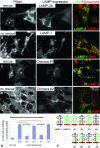

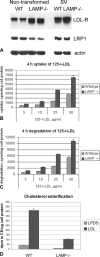

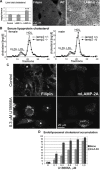
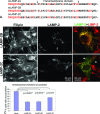
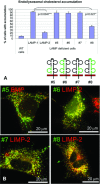
Similar articles
-
Sequestration of cholesterol within the host late endocytic pathway restricts liver-stage Plasmodium development.Mol Biol Cell. 2017 Mar 15;28(6):726-735. doi: 10.1091/mbc.E16-07-0531. Epub 2017 Jan 25. Mol Biol Cell. 2017. PMID: 28122820 Free PMC article.
-
A role for the lysosomal membrane protein LGP85 in the biogenesis and maintenance of endosomal and lysosomal morphology.J Cell Sci. 2002 Nov 1;115(Pt 21):4117-31. doi: 10.1242/jcs.00075. J Cell Sci. 2002. PMID: 12356916
-
Suppression of macrophage eicosanoid synthesis by atherogenic lipoproteins is profoundly affected by cholesterol-fatty acyl esterification and the Niemann-Pick C pathway of lipid trafficking.J Biol Chem. 2004 Feb 27;279(9):8084-92. doi: 10.1074/jbc.M310672200. Epub 2003 Nov 24. J Biol Chem. 2004. PMID: 14638686
-
Cholesterol transfer at endosomal-organelle membrane contact sites.Curr Opin Lipidol. 2018 Jun;29(3):212-217. doi: 10.1097/MOL.0000000000000506. Curr Opin Lipidol. 2018. PMID: 29629999 Review.
-
Roles of LAMP-1 and LAMP-2 in lysosome biogenesis and autophagy.Mol Aspects Med. 2006 Oct-Dec;27(5-6):495-502. doi: 10.1016/j.mam.2006.08.005. Epub 2006 Sep 14. Mol Aspects Med. 2006. PMID: 16973206 Review.
Cited by
-
Danon disease - dysregulation of autophagy in a multisystem disorder with cardiomyopathy.J Cell Sci. 2016 Jun 1;129(11):2135-43. doi: 10.1242/jcs.184770. Epub 2016 May 10. J Cell Sci. 2016. PMID: 27165304 Free PMC article. Review.
-
LAMP1 is more sensitive than LAMP2 in predicting prognosis of esophageal squamous cell carcinoma.Transl Cancer Res. 2020 Apr;9(4):2243-2248. doi: 10.21037/tcr.2020.03.27. Transl Cancer Res. 2020. PMID: 35117584 Free PMC article.
-
Isoform-dependent lysosomal degradation and internalization of apolipoprotein E requires autophagy proteins.J Cell Sci. 2022 Jan 15;135(2):jcs258687. doi: 10.1242/jcs.258687. Epub 2022 Jan 25. J Cell Sci. 2022. PMID: 34982109 Free PMC article.
-
Biological and Molecular Effects of Trypanosoma cruzi Residence in a LAMP-Deficient Intracellular Environment.Front Cell Infect Microbiol. 2022 Jan 6;11:788482. doi: 10.3389/fcimb.2021.788482. eCollection 2021. Front Cell Infect Microbiol. 2022. PMID: 35071040 Free PMC article.
-
Live imaging of intra-lysosome pH in cell lines and primary neuronal culture using a novel genetically encoded biosensor.Autophagy. 2021 Jun;17(6):1500-1518. doi: 10.1080/15548627.2020.1771858. Epub 2020 Jun 9. Autophagy. 2021. PMID: 32515674 Free PMC article.
References
-
- Eskelinen EL, Tanaka Y, Saftig P. At the acidic edge: emerging functions for lyso-somal membrane proteins. Trends Cell Biol. 2003;13:137–45. - PubMed
-
- Schröder B, Wrocklage C, Pan C, et al. Integral and associated lysosomal membrane proteins. Traffic. 2007;8:1676–86. - PubMed
-
- Hunziker W, Geuze HJ. Intracellular trafficking of lysosomal membrane proteins. Bioessays. 1996;18:379–89. - PubMed
-
- Fukuda M. Lysosomal membrane glyco-proteins. Structure, biosynthesis, and intracellular trafficking. J Biol Chem. 1991;266:21327–30. - PubMed
-
- Carlsson SR, Roth J, Piller F, et al. Isolation and characterization of human lysosomal membrane glycoproteins, h-lamp-1 and h-lamp-2. Major sialoglyco-proteins carrying polylactosaminoglycan. J Biol Chem. 1988;263:18911–9. - PubMed
Publication types
MeSH terms
Substances
LinkOut - more resources
Full Text Sources
Medical
Molecular Biology Databases
Miscellaneous

